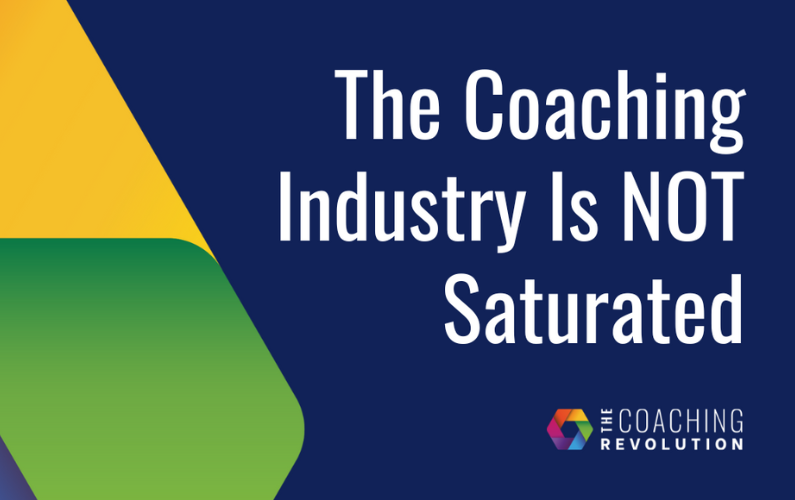There has been a lot of nonsense floating around recently about how the coaching industry is saturated.
It’s not.
The coaching industry could only be saturated if everyone who could benefit from coaching was being coached, and patently, that’s not true.
So why is it being said?
Reasons For Saying It
People generally say the coaching industry is saturated for one of two reasons.
- To sell something
- Because they’re frustrated coaches
Let’s look at these individually.
To Sell Something
A widespread phenomenon within our profession is that when client acquisition isn’t going as well as we had hoped, we look to the wrong side of our scales for the answer.
A quick explainer:
Let me explain briefly if you have yet to hear my scales analogy.
A financially viable coaching business consists of two completely separate skill sets. I like to describe these skill sets as sitting on opposite sides of an old-fashioned weighing scale, because they are equally important.
One of these skill sets is our delivery skills. These are the skills we use when we’re sitting in front of a client. Delivery skills are built via our coaching qualifications, practitioner certificates, facilitation certificates, NLP certificates, personality profiling tools etc. The list is extensive. All of these qualifications sit on the delivery side of our scales. They are delivery tools, not marketing tools.
On the other side of the scale sit the skills we need to create the opportunities to do the delivery. These are client acquisition skills, also known as sales and marketing skills. These skills are 50% of the skills needed to run a coaching business.
Back to how this is used to sell something:
To return to my point, when our client acquisition isn’t going as well as we had hoped, we tend to look to the wrong side of our scales—the delivery side. The predominant reason we do this is that many (most?) of us have no idea that the other side of our scales even exists.
What happens is that coaches tend to think this: I know I’ll take X, Y or Z additional qualifications because then I’ll have even more value to offer to my clients!
The sad truth…
The sad truth is that it’s impossible to add value to clients you don’t have.
When someone is selling a coaching programme to coaches, they could use this misguided thought process to their advantage. I didn’t say using this misunderstanding was a good or honourable thing, but it does happen. For example, they might discuss how their course will give you a competitive edge and therefore increase your success with client acquisition in this ‘saturated’ market. It won’t, of course, but that doesn’t always stop them from saying it.
The ‘evidence’ that might be used to prove that the industry is saturated is, for example, going to the LinkedIn search bar and searching for the word ‘coach’, then extrapolating the results and presenting them as statistics. This is a very good example of the quote that Mark Twain attributed to Benjamin Disraeli – lies, damned lies and statistics.
Let me explain why this is the case. People who do very different things use the job title coach. From sports coaches to ‘work coaches’ (the title given to the administrators at the UK job centres) and every coach in between, all of them will appear on a search for the word coach. The fact that not all the results are our kind of coaches needs to be clarified – but rarely is – when those results are used to spread fear and to ‘prove’ that the coaching industry is saturated.
Why Frustrated Coaches Talk About A Saturated Coaching Industry
In the same way that no one knows what a coach is, but they think they do and they’re wrong, most coaches have no idea how marketing works, but we think we do and we’re wrong.
If we are confident in our (wrong) knowledge, we follow a predictable path;
- We set off to build a coaching business by networking and talking about how we can help people reach goals and overcome limiting beliefs.
- We build websites that are basically online CVs – all about us, our coaching philosophy and our coaching packages.
- We deliver free strategy sessions to demonstrate the value of coaching.
- We believe that if we find the first client or two, the rest will come by referral.
We do these things enthusiastically initially and find our enthusiasm waning when we don’t engage the clients we thought we would, at the fees we thought they’d pay. We might find the odd client, but that’s not what we expected would happen.
This is when whispers of a saturated industry start to ring true. When you’ve used all the things you had in your arsenal and not engaged clients, it stands to reason that it must be because the clients simply aren’t there because the industry is saturated.
But it’s not saturated.
The reason the things I mentioned as being in a coach’s arsenal haven’t worked, is because they’re not marketing. They’re optimism at best and a complete waste of time at worst. Why? Because all good marketing is focused.
Look around you at the marketing that’s clear to see – usually advertisements. Look carefully and see if you can figure out who the intended audience is, because there always is one. For example, there’s a reason that Rolex advertises in Vogue and GQ instead of Hello or Bella, and that reason is that their target audience is far more likely to be reading the former.
To go back to coaches, it’s easy to see why we begin to believe that the coaching industry is saturated. And then, when we see a course promoted that preys on this belief and it says it will give us a competitive edge, we jump at it.

Recent Comments